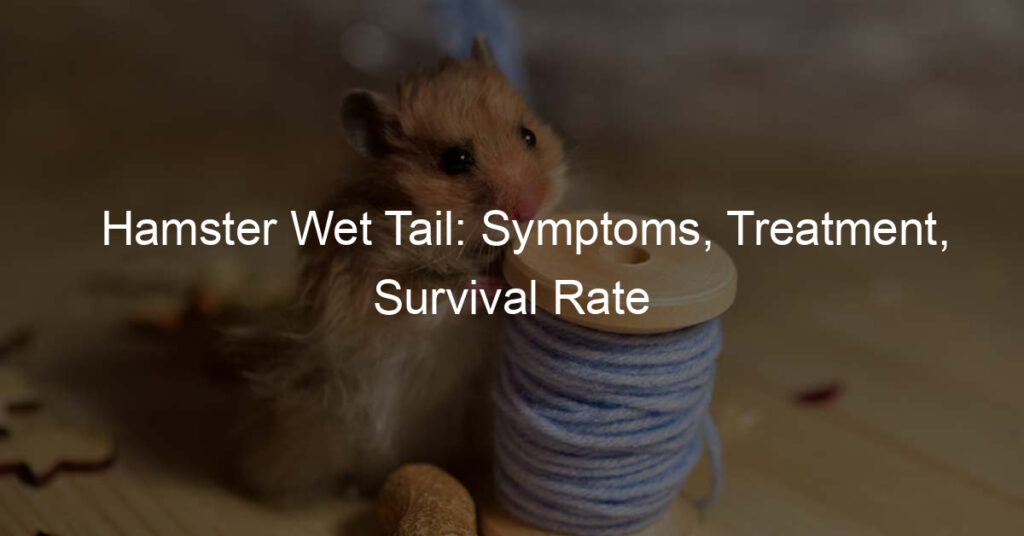If you’ve ever owned a hamster, you’re probably familiar with the term “wet tail.” Wet tail is a condition that can affect hamsters of any age, but is most common in young hamsters. Symptoms include diarrhea, lethargy, and loss of appetite. Treatment usually involves antibiotics and rehydration, and the survival rate is generally quite high.
However, the wet tails can be fatal if left untreated, so it’s important to be aware of the symptoms and seek treatment early on. Keep reading to learn more about wet tails in hamsters.
Is wet tail serious?
Wet tail is a severe gastrointestinal disease that exclusively affects hamsters and can potentially be fatal without proper treatment. Though the cause of wet tails is uncertain, it is most commonly observed in young hamsters that reside in unhygienic environments with inadequate nutrition and stress. The symptoms include diarrhea, lethargy, anorexia, dehydration, and an abnormal odor emanating from their tails.
To ensure a healthy pet life for your hamster, be sure to provide them with a clean living environment, quality food, and water sources, plenty of playtime out of the cage, and additional vitamin supplements as prescribed by your vet. Prevention is key when it comes to this serious condition so make sure you’re taking all the necessary precautions.
How to prevent wet tail
Wet tail is an unpleasant and highly contagious gastrointestinal disease that commonly affects young hamsters. Fortunately, there are many steps you can take to prevent your furry friend from experiencing this painful ailment. To keep your pet healthy, be sure to feed your hamster a balanced diet of fresh vegetables and fruits in combination with good-quality pellets and seeds.
Additionally, make sure to keep their cage clean and change the bedding regularly. Lastly, always introduce new animals or items into the cage with extreme caution – remember, a wet tail can spread quickly! With a few simple practices, you can help keep your hamster as safe and happy as possible!
Hamster wet tail treatment?
Wet tail is a common bacterial infection that can occur in hamsters. Fortunately, there are treatments available to help your hamster fight it off. If you suspect your hamster is suffering from a wet tail, it’s important to take them to the vet right away. Your veterinarian will be able to evaluate the condition, and may prescribe a course of antibiotics or recommend they receive fluids through an IV.
In addition, they will typically recommend providing warm and dry bedding for their cage and counteracting dehydration by providing more fresh fruits and vegetables than usual. Making sure your hamster gets proper treatment is essential to helping them recover from a wet tail and have a healthy future!
Will my hamster survive a wet tail?
Wet tail is a potentially deadly bacterial infection that hamsters are especially vulnerable to. While it can be treated with medication, the best way to ensure that your hamster survives this illness is by taking preventative measures. One of the most important things you can do is to provide your small friend with a clean and stress-free environment – not too hot or cold and plenty of space to play.
A nutritious diet also goes a long way towards staving off this disease, so make sure that you’re giving yours all the fruits and vegetables they need for optimal health. With proper care and attention, your furry pal should make it through wet tail without incident!
What medicine can I give my hamster for a wet tail?
Wet tail is a serious condition for hamsters that require special care. If your pet has been diagnosed with the condition, your veterinarian will likely prescribe antibiotics or metronidazole for treatment. Depending on the severity of the illness, you may also be advised to give probiotics and an electrolyte supplement to strengthen your friend’s immunity and energy.
To ensure that their system absorbs these medications properly, make sure to feed them small but frequent meals and never overfeed them. Your furry companion will likely have a complete recovery as long as they follow their vet’s instructions step by step.
How do you disinfect a hamster cage after a wet tail?
Cleaning your hamster’s cage is one of the most important parts of taking care of a pet. Unfortunately, sometimes hamsters can fall ill and you have to disinfect their cage as a result, such as in the case of wet tails. One way to do this is by mixing one cup of chlorine bleach with every gallon of water to create a solution for scrubbing down their cage and all accessories.
Once done cleaning with the solution, rinse everything off with another gallon of plain water. Doing this will help kill bacteria and fungi that cause wet tails and any other illnesses associated with it. While it may be an extra hassle when your pet isn’t feeling well, it’s worth it in the long run for their health!
Let’s Wrap it Up!
In conclusion, a wet tail is a serious health condition in hamsters and should not be taken lightly. Prevention is key but if your hamster has a wet tail, you’ll need to take them to the vet as soon as possible and keep them in clean, warm conditions. Treatment options vary depending on the severity of the condition but could include antibiotics and supportive care such as rehydration therapy.
Although a wet tail can be fatal, with quick treatment and proper care, many hamsters make a full recovery. Disinfecting the hamster’s cage after a wet tail is also important to help prevent it from spreading to other animals or family members. With the right precautions and early action, your hamster can once again live a healthy life!








